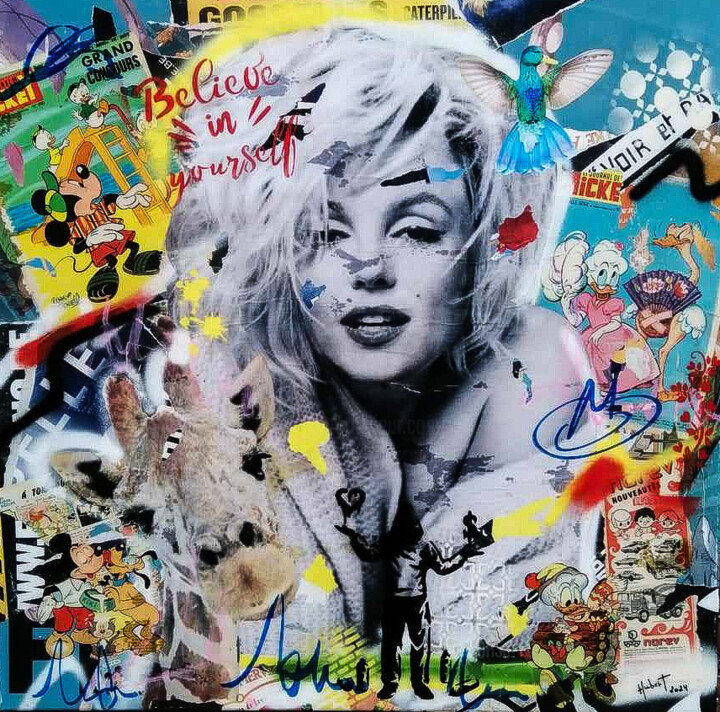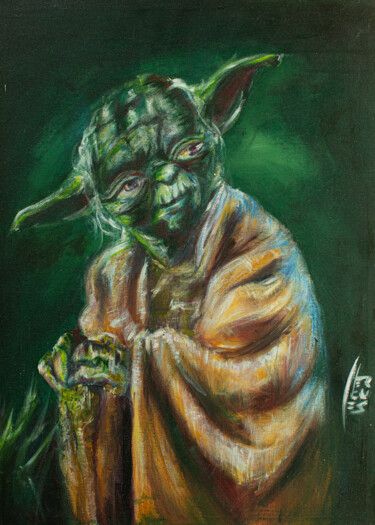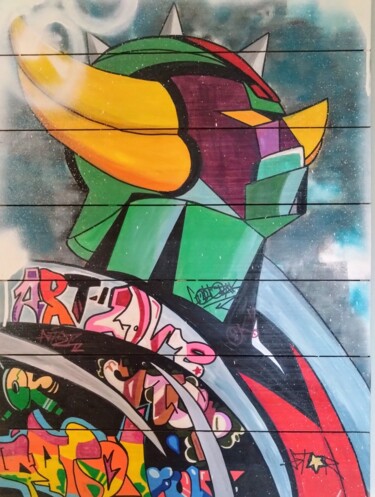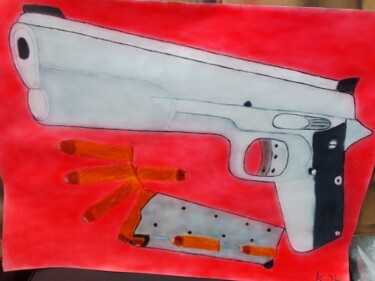69 Оригинальные произведения искусства, ограниченные тиражи и принты:
Будь то уличное искусство, городское искусство или граффити, эти новые художественные тенденции уже несколько десятилетий существуют во всех крупных городах: от Нью-Йорка до Парижа или от Лондона до Токио через Рио. Жанейро. Во-первых, слово «стрит-арт» появилось относительно недавно. Он датируется 2000-ми годами. Он был использован в 2006 году во время первых художественных аукционов, на которых были представлены произведения этого художественного направления. В 2008 году выставка «стрит-арт» в Тейт Модерн в Лондоне ввела этот термин для описания этого нового уникального художественного движения, характеризующегося большим разнообразием стилей (граффити, коллажи, трафареты, инсталляции, фрески, мозаики, наклейки...).
Можно сказать, что это глобальное художественное движение, зародившееся в 1960-х годах и живое до сих пор. Разнообразие используемых медиа, стилей, техник и свобода творчества в публичном пространстве. Это новое движение, вошедшее в историю искусства.
Кто создал стрит-арт?
На стенах с незапамятных времен находили следы искусства. Будь то теменное искусство в пещерах Ласко или имена, найденные на стенах Помпеи, искусство рисования и граффити в общественном пространстве встречается во все времена. Поэтому то, что сегодня называют уличным искусством, не является совершенно новым.
Во Франции в 1930-х годах художник Брассай, увлекающийся граффити, решил сфотографировать их, чтобы запомнить на фотографиях. В 1950-х годах Жак Виллегле (1926-) и Раймонд Хейнс собрали плакаты с улицы, чтобы воссоздать произведение искусства с помощью этих рваных кусков плаката. Таким образом, они заложили первые основы того, что позже станет уличным искусством. В то же время Жерар Злотикамен (1940-) в 1963 году начал рисовать на улице черно-красные силуэты, которые он назвал «однодневками». Он будет продолжать рисовать свои силуэты в течение нескольких лет.
Эта тема силуэтов и использование аэрозольной краски также важны в творчестве Эрнеста Пиньон-Эрнеста (1942-). Его силуэты, вырезанные по трафарету и нарисованные на стенах, — его визитная карточка. Он будет вторгаться в определенные места и стены со своими творениями, как сегодняшние художники-граффити.
В конце 1960-х годов в Филадельфии (США) первым из «графиков» был художник Корнбред, везде ставивший свою подпись. Это рождение первых тегов: заглавные буквы, нанесенные аэрозольным баллончиком. Многие молодые люди следуют их примеру и пишут свое имя на стенах.
В 1969 году Хулио 204 из Нью-Йорка одним из первых отметился в городе, он также первым добавил свой номер улицы в свою подпись. Феномен, который станет маркером нью-йоркского движения. Таки 183 действительно первый таггер, который стал известен в городе, покрывая стены и поезда метро своими автографами.
Столкнувшись с увеличением числа граффити-художников, художники начинают стремиться выделиться. Stay High 149 первыми добавили к своей подписи графические элементы, удвоив тег и добавив ореол, видимый в серии Le Saint. После этого многие художники граффити последуют его примеру, и стиль станет все более и более изобретательным. Фаза 2 — выдающийся художник, который изменит тег, создав еще более оригинальные формы букв и завершив его композицию стрелкой.
Плодовитый художник конца 1970-х годов Зен создавал работы в ярких контрастных цветах, в то время как Блейд работал над перспективой и геометрией в своих работах. Он один из первых художников, которых заметила галерея и у которого состоялась его первая выставка.
Феномен уличного искусства распространяется по всему миру.
Стиль все больше развивается, иногда отдаляясь от изначального граффити. Настоящая охота властей на художников, которые метят двери и вагоны метро, усиливается, художники вынуждены удваивать свою изобретательность в работе, быть все более и более стремительными в работе и в творчестве, чтобы иметь возможность выделиться на фоне других художников. . Это также приведет к смене места их работы и увеличению стен в качестве поддержки их достижений. Эволюция их рабочего инструмента, аэрозольного баллончика, развивается. Появляется множество цветов, а распылительные наконечники позволяют художникам использовать различную толщину линий.
Художники Futura, Dondi White, Rammellzee или A-One были ведущими художниками конца 1979-х и начала 1980-х годов в США. Они также первыми придали своей работе более или менее политический посыл. С 1979 года арт-площадки и альтернативные галереи проявляют интерес к художникам уличного искусства и выставляют их. Успех стал международным, и с 1980-х годов художники Blade, Futura или Seen выставлялись на многочисленных выставках в Европе. Европейские музеи, такие как музей Бойманса ван Бенингена в Роттердаме, приобретут произведения уличного искусства. С выставками и открытием уличного искусства в путешествиях в 1983 и 1984 годах это явление распространилось по Европе (Франция, Италия, Германия...)
В Париже первым известным художником-граффити является Бандо, который импортирует граффити во Францию и присоединяется к художникам Блеку ле Рату и Жерому Меснагеру, которые создают трафареты для художников, используя городские опоры.
Заикающиеся зачатки парижского граффити сосредоточены на берегах Сены между Пон-Нёф и Мостом Согласия. Обмены между европейскими художниками усиливаются. Таким образом, английский художник Mode 2 будет работать в Париже с Bando, который затем будет сотрудничать с голландцем Sho. Обмены также активизируются с североамериканскими артистами, такими как JonOne, который встретил Бандо в Нью-Йорке, он собирается показать ему, что делается в Париже. Затем JonOne приезжает в Париж, затем присоединяется к банде Bad Boy (BBC) и в конечном итоге остается навсегда во французской столице. JonOne будет отличаться от других художников, сосредоточившись на движении, а не на буквах. В начале 1990-х BBC выставлялась по всей Европе.
Каков посыл уличного искусства?
Если до сих пор уличное искусство было, по сути, техникой тегирования, то с 1990-х годов городское искусство переживет небольшую революцию. Некоторые художники заменяют подпись изображениями лиц, портретами... например, Шепард Фейри, он же Obey. Еще будучи студентом в 1989 году, он создал иконку «У великана Андре есть отряд» и сделал из нее наклейку, которую раздал своим друзьям с просьбой приклеить ее повсюду. Его цель состоит в том, чтобы заставить нас осознать, что все изображения, которые мы видим, имеют смысл и что важно его понимать.
Новое поколение уже не будет использовать только аэрозольный баллончик для вторжения в городское пространство, а будет использовать наклейки, коллаж, мозаику, трафарет...
Французский Space Invider вторгнется в общественное пространство, наклеив мозаику на стены, чтобы создать визуальные эффекты, вдохновленные аркадной игрой Space Invaders 1978 года. Invader установил более 3000 деталей в более чем 60 городах по всему миру.
Реагируя на визуальное загрязнение, создаваемое коммерческой коммуникацией в общественном пространстве, художник Зевс искажает логотипы крупных брендов, разжижая их на фасадах универмагов после наступления темноты. Он также будет создавать тени объектов уличной мебели, рисуя тени этих объектов на тротуарах.
На протяжении многих лет художник Бэнкси будет использовать свое искусство, чтобы осуждать недостатки общества с юмором, поэзией и шокирующими визуальными эффектами, в частности, используя технику трафарета. Его простые и изысканные сцены поражают и поражают умы. Он быстро стал одним из самых известных художников. Другие французские художники будут использовать эту технику, например, Miss.Tic, Blek le Rat, Jef Aérosol или C215.
Уличное искусство постоянно развивается. От простых граффити его начинаний до граффити Seen или JonOne, методы разнообразны. Художники граффити продолжают использовать аэрозольные баллончики для создания своих работ. Но они также используют новые техники и опоры, такие как мозаика, трафарет, наклейка, инсталляции, скульптура или видеопроекция.
Некоторые известные художники уличного искусства
Бэнкси
Художник, которому удалось сохранить свою личность в тайне от СМИ. Его работы, выполненные в основном с помощью трафарета, первоначально были созданы на улицах Лондона, а затем вторглись на улицы всего мира.
Его сатирико-подрывная работа осуществляется с целью выделения иного образа мышления, чем окружающий. Особенно средства массовой информации. Его работа сосредоточена на сильных политических и социальных требованиях.
Документальный фильм 2010 года «Выход через сувенирную лавку» был номинирован на премию «Оскар» за лучший документальный фильм.
Шепард Фейри
Родившийся в 1970 году, он современный художник, известный своими графическими сериграфами. Известный прежде всего своими наклейками, его работы стали известны благодаря его плакату Барака Обамы во время президентских выборов в США в 2008 году.
Его работы находятся в коллекциях многих музеев, таких как Музей современного искусства в Нью-Йорке и Музей Виктории и Альберта в Лондоне.
Джефф Аэрозоль
Художник родился в 1957 году. Один из пионеров уличного искусства во Франции начала 1980-х. Художник по трафарету, он создает портреты таких личностей, как Элвис Пресли, Леннон, Баския... а также анонимных людей, таких как дети, прохожие или нищие.
Цитаты художников уличного искусства
Бэнкси
«Граффити — один из немногих способов, доступных вам, когда у вас почти ничего нет. И хотя вы не можете вылечить бедность в этом мире с помощью рисунка, вы, по крайней мере, можете заставить кого-то улыбаться, пока он мочится».
«Величайшие преступления совершаются не теми, кто нарушает правила, а людьми, которые подчиняются приказам. Это те, кто сбрасывает бомбы и уничтожает деревни».
Жерар Злотикамен
«Творение — это болезнь, аномалия, от которой я не собираюсь лечиться!»
Какие крупнейшие фестивали уличного искусства?
По всему миру проходит множество фестивалей уличного искусства и городского искусства:
- Во Франции — Grenoble Street Art Fest, Underground effect в Paris la Défense, Zoo Art Show в Лионе.
- В Великобритании Bristol's Upfest
- В Норвегии NuArt
- В Канаде фреска Монреаля
- В Испании Asalto, Сарагоса, Bloop Festival, Ибица, Arco Madrid, Miau Fanzara
- В США, Wynwood Miami, Программа настенных искусств Джерси-Сити, Detroit - Murals In The Market, Гавайи Kaka'ako - Pow! Вау!, Сакраменто - Широко открытые стены, Атланта - Живые стены
- В Бельгии, Остенде - Хрустальный корабль
- В Швейцарии Арт Базель
- В Польше, Лодзь - городские формы
- В Китае, Гонконге — Hkwalls
Какие фильмы посмотреть на стрит-арте?
- Добраться до стены: документальный фильм о Бэнкси
- Chats perchés: документальный фильм на M Chat
- Режиссёром выступил французский уличный художник JR.
- Центр города 81 - Жан-Мишель Баския: фильм возвращается к началу карьеры Баския.
- Станции надземных: документальный фильм о граффити в Нью-Йорке.
- Дикий стиль , фильм 1980-х годов: документальный фильм об американской городской культуре и граффити.
- Писатели 1983-2003, 20 лет граффити в Париже
Discover contemporary artworks on Artmajeur
Contemporary art is a vibrant constellation of artistic expressions. This creative universe encompasses a wide array of mediums, from paintings, sculpture, and photography to drawing, printmaking, textile art, and digital art, each medium a star shining with its own distinct radiance. Artists use diverse supports and materials to bring their visions to life, such as canvas, wood, metal, and even innovative digital canvases for the creation of virtual masterpieces.
A contemporary painting, for instance, may weave its story through the masterful strokes of acrylic or oil, while a contemporary sculpture might sing its song in the language of stone, bronze, or found objects. The photographic arts capture and manipulate light to produce striking images, while printmaking employs techniques like lithography and screen-printing to produce multiples of a single, impactful image. Textile art plays with fabrics and fibers, whereas digital art pushes the boundaries of creation with innovative technology.
The allure of contemporary art lies in its boundary-pushing nature, its relentless quest for experimentation and its constant reflection of the evolving human experience. This boundless creativity, coupled with its strong social and personal commentary, makes every piece of contemporary art a unique emblem of its time, a mirror held up to the realities and dreams of our complex world. It whispers to us, moves us, provokes thought, and kindles a deep emotional response, stirring the soul of anyone willing to listen. It is, indeed, the language of emotions and ideas, spoken in the dialect of our era.

©2024 Sohan_street
Origins and history of contemporary art
The story of contemporary art unfolds in the mid-20th century, marked by seismic shifts in artistic expression. Post-World War II, around the 1950s and 1960s, artists began experimenting beyond traditional confines, challenging the norms of what art could be. This revolutionary epoch birthed myriad new movements and artistic forms such as abstract expressionism, pop art, and minimalism. Paintings, once confined by realism, embraced abstraction, as artists used color and form to express emotions and ideas. Notable periods like the advent of pop art in the late 1950s and early 1960s saw artworks mimicking popular culture and mass media, reflecting society’s shifting focus.
The sculptural arts, too, witnessed a metamorphosis. Sculptors started to experiment with new materials and forms, often creating artworks that interacted with the viewer and the surrounding space, fostering a sense of engagement. Drawing, a timeless practice, also evolved, with artists incorporating innovative techniques and concepts to redefine its role in contemporary art.
Photography, a relatively new medium, emerged as a powerful tool in the contemporary art landscape. Born in the 19th century, it truly came into its own in the latter half of the 20th century, blurring the lines between fine art and documentation. Printmaking, a practice dating back to ancient times, saw renewed interest and experimentation with techniques like lithography, etching, and screen printing gaining prominence.
The realm of textile art expanded dramatically, as artists began to appreciate the versatility and tactile quality of fabric and fibers. Artists began using textiles to challenge the boundaries between fine art, craft, and design.
The dawn of digital technology in the late 20th century heralded a new age for contemporary art. Digital art emerged as artists started leveraging new technologies to create immersive, interactive experiences, often blurring the line between the virtual and the physical world.
Through these transformative periods, the essence of contemporary art has remained the same: a dynamic, evolving reflection of the times we live in, continually pushing boundaries and embracing the new, always questioning, always exploring.

©2022 Chris Rose
Evolutions of theses contemporary works in the art market
As we navigate through the 21st century, the dynamic landscape of contemporary art continues to evolve and expand, reflecting our ever-changing world. Contemporary paintings, once primarily confined to two-dimensional canvases, now embrace a multitude of forms and techniques, ranging from mixed media installations to digital creations, each piece a rich a weaving of thoughts, emotions, and narratives. Sculpture, too, has ventured far beyond traditional stone and bronze, with artists incorporating light, sound, and even motion, embodying the ephemerality and flux of the modern world.
Photography, in the hands of contemporary artists, has expanded its horizons, seamlessly blending with digital technology to create breathtaking imagery that challenges our perception of reality. Drawing, as well, has transcended the borders of paper, incorporating multimedia elements and exploratory techniques to redefine its role in the artistic discourse. Printmaking continues to flourish, with contemporary artists using traditional methods in innovative ways to deliver potent social and personal commentaries.
Textile art, once considered a craft, now holds a prominent place in the contemporary art world, with artists using it to explore issues of identity, tradition, and cultural heritage. Meanwhile, digital art, the newest member of the contemporary art family, has revolutionized the way we create and interact with art, presenting immersive experiences that blur the boundary between the virtual and the physical.
These diverse forms of contemporary art hold significant value in the current art market, not only due to their aesthetic appeal but also their ability to encapsulate and communicate complex ideas and emotions. Collectors, curators, and art lovers worldwide seek these works, drawn to their inherent dynamism, their innovative use of materials, and their eloquent expressions of our shared human experience. As a testimonial to our times, these contemporary artworks encapsulate the pulse of our society and the resonance of individual voices, forever etching our collective narrative into the annals of art history.

©2024 Fabrice Hubert
Famous Contemporary Artists
As we delve into the vibrant realm of contemporary art, we encounter an array of artists who shape this dynamic field. Each a master in their medium - painting, sculpture, photography, drawing, printmaking, textile, or digital art - they push artistic boundaries, reflecting our era and challenging perceptions. Let’s explore these remarkable contributors and their groundbreaking works.
1. Gerhard Richter - Known for his multi-faceted approach to painting, Richter challenges the boundaries of the medium, masterfully oscillating between abstract and photorealistic styles. His works, whether featuring squeegee-pulled pigments or blurred photographic images, engage in a fascinating dialogue with perception.
2. Jeff Koons - A significant figure in contemporary sculpture, Koons crafts monumental pieces that explore themes of consumerism, taste, and popular culture. His iconic balloon animals, constructed in mirror-polished stainless steel, captivate with their playful yet profound commentary.
3. Cindy Sherman - An acclaimed photographer, Sherman uses her lens to explore identity and societal roles, particularly of women. Renowned for her conceptual self-portraits, she assumes myriad characters, pushing the boundaries of photography as a medium of artistic expression.
4. David Hockney - Hockney, with his prolific output spanning six decades, is a pivotal figure in contemporary drawing. His bold use of color and playful exploration of perspective convey an intoxicating sense of joy and an unabashed celebration of life.
5. Kiki Smith - An innovative printmaker, Smith’s work explores the human condition, particularly the female body and its social and cultural connotations. Her etchings and lithographs speak to universal experiences of life, death, and transformation.
6. El Anatsui - A master of textile art, Anatsui creates stunning tapestry-like installations from discarded bottle caps and aluminum scraps. These shimmering, flexible sculptures blend traditional African aesthetic with contemporary art sensibilities, speaking to themes of consumption, waste, and the interconnectedness of our world.
7. Rafael Lozano-Hemmer - A leading figure in digital art, Lozano-Hemmer utilizes technology to create interactive installations that blend architecture and performance art. His work, often participatory in nature, explores themes of surveillance, privacy, and the relationship between people and their environments.

©2024 Sohan_street
Notable contemporary artworks
The contemporary art landscape is a dynamic patchwork of diverse expressions and groundbreaking ideas, each artwork a unique dialog with its audience. Here are a selection of some renowned contemporary artworks, spanning various media such as painting, sculpture, photography, drawing, printmaking, textile art, and digital art, that have profoundly influenced this vibrant movement.
"Cloud Gate" by Anish Kapoor, 2006 - This monumental stainless steel sculpture, also known as "The Bean," mirrors and distorts the Chicago skyline and onlookers in its seamless, liquid-like surface, creating an interactive experience that blurs the line between the artwork and the viewer.
"Marilyn Diptych" by Andy Warhol, 1962 - An iconic piece of pop art, this silkscreen painting features fifty images of Marilyn Monroe. Half brightly colored, half in black and white, it reflects the dichotomy of celebrity life and its influence on popular culture.
"Rhein II" by Andreas Gursky, 1999 - This photographic artwork, a digitally-altered image of the Rhine River, is celebrated for its minimalist aesthetic. It strips the landscape to its bare essentials, invoking a sense of tranquility and vastness.
"Black Square" by Kazimir Malevich, 1915 - A revolutionary painting in the realm of abstract art, this piece, featuring nothing more than a black square on a white field, challenges traditional notions of representation, symbolizing a new era in artistic expression.
"Puppy" by Jeff Koons, 1992 - This giant sculpture, a West Highland Terrier blanketed in flowering plants, explores themes of innocence, consumer culture, and the interplay between high art and kitsch. It’s a delightful blend of traditional sculpture and garden craft.
"Re-projection: Hoerengracht" by Ed and Nancy Kienholz, 1983-1988 - A room-sized tableau representing Amsterdam’s red-light district, this work combines elements of sculpture, painting, lighting, and found objects. It engages viewers in a stark commentary on commodification and objectification.
"Untitled" (Your body is a battleground) by Barbara Kruger, 1989 - This photomontage, combining black-and-white photography with impactful text, explores issues of feminism, identity, and power. Its potent, confrontational message is a prime example of the power of text in contemporary visual art.
"For the Love of God" by Damien Hirst, 2007 - This sculpture, a platinum cast of a human skull encrusted with 8,601 diamonds, probes themes of mortality, value, and the human fascination with luxury and decadence. It’s a compelling blend of macabre and magnificence.
"Physical impossibility of Death in the Mind of Someone Living" by Damien Hirst, 1991 - This artwork, featuring a tiger shark preserved in formaldehyde, blurs the line between traditional sculpture and biological specimen. It prompts viewers to contemplate mortality and nature’s ferocity.
"One and Three Chairs" by Joseph Kosuth, 1965 - A piece of conceptual art, it presents a physical chair, a photograph of a chair, and a dictionary definition of a chair, thus exploring the relationship between language, picture, and referent in art.
These pieces, in their diversity, exemplify the rich tapestry of contemporary art, each piece a unique commentary on our world and a testament to the limitless potential of creative expression.

Click
Трафарет на Холст | 15,8x11,8 in

Fabrice Hubert
Коллажи на Дерево | 31,5x23,6 in

Frob
Акрил на Холст | 45,3x29,5 in

Artistikthanh
Акрил на Дерево | 48,8x27,6 in

Frob
Акрил на Холст | 45,3x29,5 in

Fabrice Hubert
Коллажи на Холст | 35,4x35,4 in

Artistikthanh
Акрил на Льняной холст | 31,9x25,6 in

Click
Акрил на Другой субстрат | 12,4x9,1 in

Fabrice Hubert
Акрил на Холст | 19,7x19,7 in



























